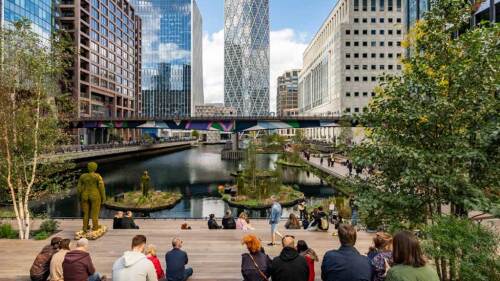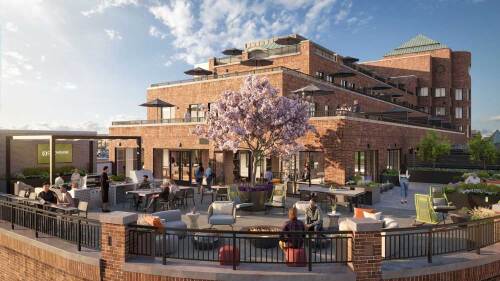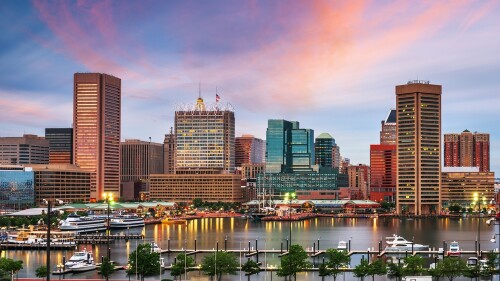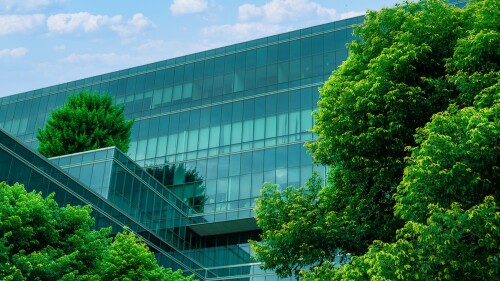About half the world’s population now lives in cities and generates 80 percent of greenhouse gas emissions. By 2050, 70 percent of the world’s population will live in urban areas. The growing specter of irreversible climate change has ignited responses by cities worldwide, generating game-changing innovations that may accelerate a positive transition for the climate and ultimately save the world.
Increasing concern about the impact of growth on climate change has prompted governments worldwide to implement policies and initiatives aimed at growing communities in climate-positive ways—that is, so that they have a zero-carbon footprint and/or offset more carbon than they generate. But the heavy lifting involved in meeting this challenge has fallen primarily to local governments.
The California Experiment
California, for example, has enacted laws to reduce the state’s carbon footprint, but left it up to local governments to implement climate change solutions. The California Global Warming Solutions Act of 2006, Assembly Bill 32, requires cities to reduce carbon dioxide emissions to 25 percent below 1990 levels by 2020 and to 80 percent below 1990 levels by 2050.
Faced with this mandate, many cities have adopted green building standards for public and commercial projects and implemented programs designed to conserve resources and reduce waste and greenhouse gas (GHG) emissions, notes lawyer Silvia Saucedo, who heads the sustainability and government advocacy practice at Beverly Hills–based Raines Law Group.
Los Angeles adopted an ordinance that requires new and large renovated buildings to meet Leadership in Energy and Environmental Design (LEED) Silver criteria. “The city uses LEED criteria to judge how green a project is, but does not necessarily require certification [through the LEED program],” says Saucedo, who helped Los Angeles develop the ordinance. Los Angeles also is updating arcane building codes that conflict with green building standards, she says, noting, for instance, that current code forbids landowners catching rainwater to irrigate landscaping because rainwater cannot be retained on site.
Elizabeth Watson, who specializes in land use as a partner at the Los Angeles law firm Greenberg Luster, points out that cities requiring developers to meet the LEED standard—including, in southern California, Santa Monica, Long Beach, Thousand Oaks, and Pasadena—only imposed that standard on the private sector after applying it to their own buildings. She predicts that local governments will eventually require owners to upgrade existing buildings to sustainable standards, too. Los Angeles has already started sustainable retrofits of its own buildings, she says, and once the city determines it is reasonable to demand sustainability upgrades, it is likely to make sellers upgrade buildings to LEED standards before they change hands.
This idea got a boost in 2009 when California enacted a law that requires owners to disclose a building’s energy rating to prospective buyers and renters. While this policy is intended as a “buyer beware” statute, the state is using the information to create a database of building energy use. The idea is that if building owners are forced to disclose this information periodically or when a property is sold or leased, they will upgrade the building’s energy systems to improve marketability, says Toni Liou, a principal at Los Angeles–based Partner Energy, an energy consulting firm that works with building owners and users to improve buildings’ energy ratings.
Another law, 2008’s Senate Bill 375, connects land use with A.B. 32 goals. It calls for cities to adopt a general plan with a sustainable communities strategy that requires new development to be near transit or clustered with existing development. The law is not mandatory, but cities must comply in order to receive a share of the state’s annual $6 billion in transportation funds. The law also exempts qualifying smart growth projects from the state’s environmental review process.
The goal of S.B. 375 is to promote creation of pedestrian-friendly neighborhoods with a balance of housing and jobs near public transit, says Nathan Cherry, vice president and director of planning and urban design in RTKL’s Los Angeles office. “Integrating development with public property will be the huge outfall of S.B. 375 and an outgrowth of what’s happening as a result of [escalating] values,” he suggests.
With increased pedestrian activity, sidewalks become a valued public space with layers of services that provide a high-quality pedestrian experience, notes Cherry, author of the 2009 book Grid/Street/Place: Essential Elements of Sustainable Urban Districts and lead designer for L.A. Live. Among the amenities in such places are canopied transit stops, water fountains, public art, newsstands, cafés, restaurants, and wayfinding signs and other graphics.
For example, L.A. Live, the 1 million-square-foot (93,000-sq-m) entertainment complex in downtown Los Angeles, is located on public property, which generates substantial pedestrian traffic, and thereby added value in naming rights to leverage the project.
Early Adopter Lessons
While California is the most aggressive state regarding sustainable policy, Austin and Seattle are the only two major American cities to formally commit to going carbon neutral. Austin began the move to carbon neutrality in 2007 with adoption of the Austin Climate Protection Plan (ACPP), which calls for city facilities to be carbon neutral by 2020 and the entire city to reach that goal by 2030.
Austin Energy, the municipal utility, got the ball rolling by capping its own carbon emissions and establishing policies and incentives to encourage residents and businesses to increase energy efficiency and reduce energy consumption. The utility also mandated that new energy coming on line be carbon-emissions free, and 30 percent of the city’s energy portfolio must be from renewable energy sources by 2020.
Austin also requires an energy audit and disclosure of energy ratings to buyers for homes and commercial buildings ten years old or older. The city is developing a carbon-neutral building certification program and updating building and energy codes to reflect this goal. By 2015, all new single-family homes must be capable of meeting 100 percent of their energy needs with on-site energy generation, and new nonindustrial buildings must perform at 75 percent energy efficiency.
The city recently rolled out the Austin Comprehensive Plan update, which connects land use to sustainability goals for the environment, economy, and social equity. An interim overlay plan in downtown is already generating transit-oriented development around transit stations along Capital MetroRail’s newly opened Red Line light-rail system.
Last November, Austin voters approved a $90 million bond issue for mobility infrastructure that expands bikeways, walkways, and public transit. Meanwhile, the city is creating programs to encourage downtown workers to drive less, including a neighborhood carpooling service, plus a car sharing program for people who commute by mass transit, bike, or foot, but may occasionally need to use a car. The city also is converting its fleet of vehicles to run on electricity and plans to install electric charging stations downtown and at city facilities to encourage residents to buy electric vehicles.
Seattle, known as the Emerald City, is recognized internationally for its environmentally conscious residents, cutting-edge environmental programs, and achievements in sustainability. The city adopted climate-action strategies in 1994 that have reduced GHG emissions to 7 percent below the 1990 level and enabled the municipal utility to achieve net zero emissions.
Steve Moddemeyer, a principal at the Seattle-based architecture firm CollinsWoerman who specializes in infrastructure, notes that the Seattle Green Factor program illustrates the city’s big-picture approach to infrastructure. This program, which is being copied by cities nationwide, requires that 30 percent of an urban project’s site contain vegetation. Tree-lined streets, green rooftops, green walls, and bioswales provide a cooler atmosphere in summer and handle drainage naturally, as well as offer aesthetic and lifestyle benefits.
“Cities own some of the most dense land, but it isn’t being leveraged to provide the greatest benefits due to the narrow focus on money,” Moddemeyer says. Infrastructure with multiple benefits or functions often costs less than the perceived “least-cost model,” he says.
For example, preliminary figures indicate that a sustainable, on-site sewage treatment plant proposed for Yesler Terrace, a 28-acre (11-ha) Seattle Housing Authority residential project, would cost less than the business-as-usual model. The system would use sewer water, which maintains a constant 72-degree temperature, to create a thermal-loop, heat exchange system to heat the entire project. The system also would filter blackwater, reclaiming it for nonpotable uses such as irrigating landscaping or flushing toilets, which would reduce consumption of potable water.
Greening the World
Meanwhile, global organizations such as the United Nations Environmental Programme (UNEP) and the Clinton Climate Initiative (CCI) are accelerating climate action by increasing awareness of the consequences of climate change and economic opportunities provided by sustainable development.
UNEP facilitates information exchange among members, and CCI shines the spotlight on projects that demonstrate how communities can grow in climate-positive ways. CCI has identified 16 projects on six continents that “are doing it right,” says Moddemeyer, who is as an adviser to the program.
These 16 projects are designed on a fully integrated thinking (FIT) eco-performance matrix, which integrates environmental, social, and economic components of development, says Rob Marshall, senior vice president for the Planning Group at HOK, a global design and engineering firm. FIT helps designers develop best practices and serves as a process or checklist of various aspects of a community that should be addressed in the planning process, he says.
Masdar City, a self-contained, zero-carbon city being built by the United Arab Emirates near Abu Dhabi, is attempting to be the first CCI climate-positive project built “out of the sand,” Marshall notes. A sustainable research complex was completed last year, and the U.A.E. has broken ground on the next, larger phase.
The U.A.E. is sparing no expense to make Masdar City a showplace that is sustainable and diversified economically. The project combines innovative ecological design with a free trade zone to provide a global model for a sustainable economy and living environment. The city is expected to attract about 1,500 companies with various business interests.
Marshall points out that new development provides an opportunity to plan a community on a vision that is specific and responsive to a region’s unique environment. Designed by London-based Foster + Partners, Masdar City blends time-tested ancient construction practices with high-tech design. The city is raised 23 feet (7 m) off the desert floor to catch the prevailing breezes and will produce all the clean energy it uses. An asymmetric configuration amasses buildings in such a way that one side of the street is shaded to create a pedestrian environment. No traditional cars will be allowed. Instead, driverless electric vehicles will navigate a maze of tunnels under sidewalks to move people around the city.
In California, starting from scratch is allowing developers of Tejon Ranch in northeast Los Angeles County to meet the state’s GHG mandate. The project is the first large-scale development planned to meet A.B. 32 requirements, says Barry Zoeller, vice president of corporate communications and marketing for California developer Tejon Company LLC.
Tejon Ranch, which will include the 12,000-acre (4,900-ha) Centennial new town, a village resort, and a commercial distribution center, will employ solar and other emerging clean-energy technologies. But wind power is off the table because of the harm wind turbines can do to the California condor, Zoeller says.
Green Economic Power
| A zero-energy casita in Fort Worth, Texas, is powered solely with a wind turbine. |
Economics is a strong motivation for communities to go green, particularly in developing nations like China and India. Thomas Hudson, a principal at CollinsWoerman, says sustainable economic development involves like-minded community stakeholders in the process and targets businesses that match the community’s assets and share its values. Baoding, a Chinese fishing village 100 miles (160 km) southwest of Beijing, applied such a model to become the world’s first carbon-neutral city over the course of just three years.
Baoding’s effort began when thousands of fish in the region’s largest lake died suddenly. After researching potential economic opportunities that fit the region’s workforce, the city’s new mayor Yu Qun decided to replace several hundred dirty automobile and textile factories with a renewable energy cluster modeled after California’s Silicon Valley. Branding the new enterprise zone Electricity Valley, Qun used incentives to attract nearly 200 green technology industries that manufacture everything from blades for wind turbines to solar panels. The city is carbon neutral because it produces equipment that offsets more GHG emissions worldwide than the community generates.
While economic growth in China and India has increased carbon production at an alarming rate, “China sees the value in the sustainability agenda and is moving quickly,” says Timothy Beatley, Teresa Heinz Professor of Sustainable Communities at the University of Virginia School of Architecture. He notes that China has rolled out impressive high-speed trains and is pushing the envelope with investments in innovative techniques and renewable energy technologies. “China deserves credit and respect,” Beatley says. “It has a bigger aggregate footprint than the U.S., but it’s doing better at the per capita level than we are.”
Seeding Innovation
In fact, China and India are serving as laboratories for new technologies and trying out visionary concepts created by foreign architects and engineers. William McDonough, a U.S. architect associated with the green movement in America and author of Cradle to Cradle: Remaking the Way We Make Things, is working on conceptual plans for 12 Chinese cities, which the government plans to build to accommodate the movement of people from farms to urban areas.
The first one to break ground is Sino-Singapore Tianjin Eco-city. Located on salty flatlands 24 miles (40 km) from Tianjin and 93 miles (150 km) from Beijing, this city of 350,000 people will serve as a prototype for new cities China plans to build as the economy grows. The Chinese partnered with Singapore 50/50 on this $10 billion project to leverage Singapore’s expertise in building wind, solar, waste treatment, and seawater desalination facilities. While the government has not promised zero carbon emissions at Tianjin, it has pledged that 90 percent of the city’s traffic will involve public transportation and that 20 percent of residential development will be public housing.
| A custom home on Lake MacLeod north of Pittsburgh |
Meanwhile, a proposed project in India’s highlands may serve as a model for the next generation of sustainable cities. HOK, which has partnered with the Montana-based Biomimicry Guild to adapt biomimicry principles to the built environment, is using Lavasa Hill Station, an 11,200-acre (4,500-ha) new town, to develop guidelines for designing communities that perform like nature.
The three-year-old alliance uses a “genius of place” approach to develop design solutions that emulate nature’s best ideas for sustaining life in a specific location, notes Taryn Mead, the guild’s senior biologist at the Design Table.
Lavasa, for example, is a planned city to be located in a deciduous forest that gets up to 11 meters [433 inches] of torrential rainfall during the three-month monsoon season, but is dry the rest of the year. Due to the canopy of leaves, 20 to 30 percent of the rain never hits the ground and evaporates through an up current; 50 to 60 percent of rain infiltrates soil; and the rest runs off. HOK plans to build a system that mimics what the tree canopy does in the forest. This could take the form of a building that creates an up current or a rainwater collection system that holds the water until 20 to 30 percent evaporates.
Lavasa Corp. Ltd. has completed construction on the first phase of the project, a 1,700-acre (700-ha) new town. But a legal challenge launched by the Indian Ministry of Environment and Forests (MoEF) halted construction this January on the next phase of the project. The lawsuit involves damage to the hillside incurred during excavation. MoEF wants a fund to be established to ensure that any damage to the environment will be restored.
What is important about all these sites is that they set “stretch goals” that quicken the pace of architectural and technological innovations, Ann Rappaport, a lecturer in urban and environmental policy at Tufts University, suggested in a 2008 BusinessWeek special report titled “Rise of the Carbon-Neutral City.” Adds Alex Steffen, cofounder and executive editor of Worldchanging.com, “Frankly, we need an avalanche of innovation. Such projects serve to push the boundaries of green practice and expand our sense of what’s possible.”







